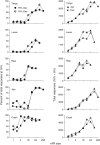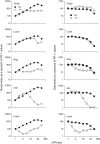Concurrent nonindependent fixed-ratio schedules of alcohol self-administration: Effects of schedule size on choice
- PMID: 27402525
- PMCID: PMC5095790
- DOI: 10.1002/jeab.215
Concurrent nonindependent fixed-ratio schedules of alcohol self-administration: Effects of schedule size on choice
Abstract
Choice behavior was studied under concurrent nonindependent fixed-ratio fixed-ratio (nFR) schedules of reinforcement, as these schedules result in frequent changeover responses. With these schedules, responses on either operandum count toward the completion of the ratio requirements of both schedules. Five monkeys were subjects, and two pairs of liquid reinforcers were concurrently available: 16% (w/v) and 0% ethanol or 16% and 8% ethanol. For each pair of reinforcers, the nFR sizes were systematically altered across sessions while keeping the schedule size equal for both liquids. Responding varied as a function of reinforcer pair and nFR size. With the 16% and 0% pair, higher response rates were maintained by 16% and were an inverted U-shape function of nFR size. With 16% and 8%, a greater number of responses initially occurred on the schedule that delivered 8% ethanol. However, as nFR size increased, preference reversed such that responses that delivered 16% ethanol were greater. When the nFR size was subsequently decreased, preference reverted back to 8%. Number of responses emitted per delivery was a dependent variable and, in behavioral economic terms, was the price paid for each liquid delivery. With 16% and 0%, changeover responses initially increased and then decreased as schedule size became larger. In contrast, with the 16% and 8% pair, changeover responses increased directly with schedule size. Responding under nFR schedules is sensitive to differences in reinforcer magnitude and demonstrates that relative reinforcing effects can change as a function of schedule size.
Keywords: alcohol self-administration; changeover responses; choice; mouth-contact response; nonindependent fixed-ratio schedules; preference reversal; rhesus monkeys; schedule size.
© 2016 The Authors Journal of the Experimental Analysis of Behavior published by Wiley Periodicals, Inc. on behalf of Society for the Experimental Analysis of Behavior.
Figures








References
-
- Banks, M. L. , Hutsell, B. A. , Blough, B. E. , Poklis, J. L. , & Negus, S. S. (2015). Preclinical assessment of lisdexamfetamine as an agonist medication candidate for cocaine addiction: Effects in rhesus monkeys trained to discriminate cocaine or to self‐administer cocaine in a cocaine versus food choice procedure. International Journal of Neuropsychopharmacology, 18, 1–10. - PMC - PubMed
-
- Bickel, W. K. , & Madden, G. J. (1999). A comparison of measures of relative reinforcing efficacy and behavioral economics: Cigarettes and money in smokers. Behavioural Pharmacology, 10, 627–637. - PubMed
-
- Carr, K. D. (2002). Augmentation of drug reward by chronic food restriction: Behavioral evidence and underlying mechanisms. Physiology & Behavior, 76, 353–364. - PubMed
-
- Carroll, M. E. , & Meisch R. A. (1984). Enhanced drug‐reinforced behavior due to food deprivation In Thompson T., Dews P. B., & Barrett J. E. (Eds.) Advances in behavioral pharmacology (Vol. 4, pp. 47–88). New York: Academic Press.
-
- Davison, M. , & McCarthy, D. (1988). The matching law: A research review. Hillsdale, NJ: Erlbaum.
MeSH terms
Substances
LinkOut - more resources
Full Text Sources
Other Literature Sources

